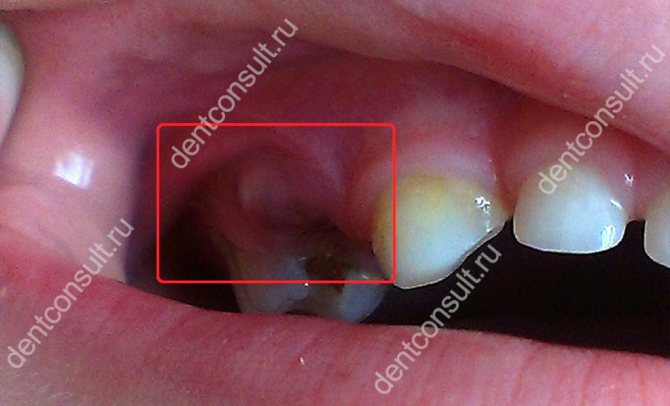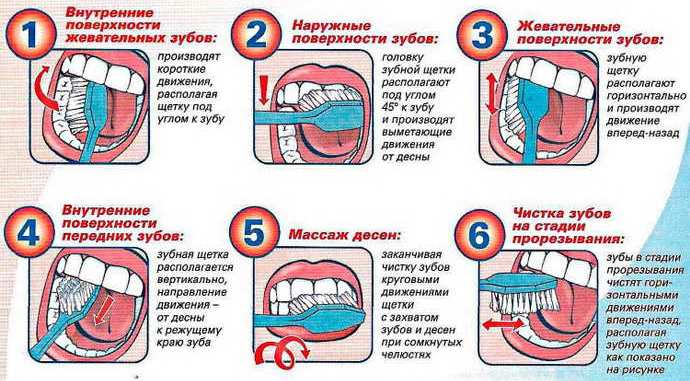Why flux develops in children - the main risk factors
In childhood, gumboil usually develops due to infection of the soft tissues in the oral cavity. Most often, the infection enters the peri-root area through a tooth affected by caries. Leukocytes concentrate within the lesion in order to resist harmful microorganisms, die, resulting in the formation of purulent exudate. Gradually, it accumulates in the resulting cavity, creating pressure on the surrounding tissues and provoking their inflammation. As a result, a painful lump appears on the gum and swelling develops.
As a rule, the following prerequisites lead to the occurrence of such a pathological process:
- advanced caries process and pulpitis,
- mechanical damage to the gums or cheeks,
- inflammatory process in gum pockets,
- low level of hygiene,
- failure to comply with the rules of asepsis during dental treatment,
- infectious diseases of ENT organs, etc.
Caries can cause the appearance of pathology
Flux in a child aged 5-7 years can appear as a reaction of the body to a sharp decrease in the immune system due to frequent colds1. There is also confirmed evidence that a hereditary factor may become a secondary prerequisite for the development of the disease. If parents often suffer or suffered from a similar problem in childhood, the child is at risk.
What is periostitis
This disease of the oral cavity in an advanced state causes an abscess of the soft tissues of the tooth. To prevent inflammation surrounding the tooth, it is necessary to familiarize the child with the rules of oral hygiene. You will have to periodically examine the child’s gums and teeth to promptly identify pathological changes. Be sure to undergo a scheduled preventive examination with a dentist twice a year.
When you identify the first symptoms of gumboil development in a child, contact a specialist for the necessary treatment. Delaying time can lead to complications in the course of the disease and the appearance of secondary disorders that can harm the life and health of the baby.
Features of the pathological process
Periostitis can occur in acute or chronic form. In the first case, a small patient exhibits all the signs of gum suppuration, severe swelling and acute pain in the causative tooth, which intensifies with mechanical action. Often the characteristic symptoms are accompanied by high temperature.
If appropriate medical care is not provided in time, you may face the risk of the pathological process becoming chronic. In such a situation, the disease becomes even more dangerous, even though the acute symptoms usually subside.

The mucous membrane turns red and swells within the pathological focus
In no case should they remain idle or try to correct the situation with improvised means without first visiting a doctor. The advice of traditional medicine really helps to relieve acute manifestations of the disease, but this does not mean that the pathology can be completely cured in this way. The infection will continue to spread through soft and even bone tissues, which can result in serious serious complications.
Clinical characteristics and diagnosis
The appearance of flux is difficult not to notice. The child becomes anxious because unpleasant sensations arise in the mouth, and the baby begins to experience obvious discomfort. In this case, visual signs of the pathological process are usually visible to the naked eye. The main symptoms of flux include the following:
- the appearance of a purulent lump on the gum,
- aching pain within the inflamed area,
- swelling of the face on one side,
- enlarged lymph nodes, pain when pressing,
- redness of the mucous membrane within the pathological focus,
- the appearance of an unpleasant odor from the mouth,
- general weakness, fever.

General weakness and swelling of the face appears on one side
“When my son was 5 years old, gumboil came out on his upper jaw. Of course, we went straight to the dentist. He opened his tooth and prescribed rinsing with soda, salt and iodine. By evening everything seemed to calm down, the child stopped crying and calmed down. The next day I saw that the balloon had inflated again. We went to the doctor, he cleaned everything there again and said we need to keep an eye on it. We stayed at home for a couple of days, then went back to the doctor. He looked carefully, everything seemed to be gone, and he put a filling. This is such an epic.”
MilaKar89, from correspondence on the woman.ru forum
The further you go, the more acute the symptoms become. So, swelling can spread to the entire cheek, right up to the eyes. However, only a qualified dentist can correctly diagnose the disease. In the case of periostitis, it is important to begin treatment as soon as possible in order to prevent the development of serious consequences. In some situations, patients are sent for x-rays to differentiate the diagnosis and exclude other inflammatory pathologies, as well as check the condition of the bone tissue.
How to recognize flux of baby teeth in a child
Flux of baby teeth in children manifests itself in the same way as in adults:
- in the oral cavity on the gum a “bump” with purulent contents is noticeable;
- the gums are swollen and red;
- the tumor spreads to the cheekbone, cheek, and sometimes covers the entire half of the face on the side where the inflammation began.
At the same time, the body temperature rises, and the lymph nodes in the neck may enlarge. Children are still too young to be able to describe the nature and localization of pain, but they undoubtedly exist, often pulsating, radiating to the temple or back of the head. The child becomes capricious and whiny, refuses food, and has intermittent and restless sleep.
What you should never do - common mistakes
There are a number of important rules that parents should definitely follow when checking for signs of gumboil development in their child. Experts in the field of pediatric dentistry put forward the following categorical prohibitions in this regard:
- apply heat to the cheek from the side of the diseased tooth - such a compress can cause the infection to spread to the throat, ears and other parts of the body,
- giving a child antibiotics - the decision to prescribe such serious drug therapy can only be made by a professional doctor. Otherwise, potent drugs can negatively affect the health of the baby’s body,
- try to open the abscess yourself - again, only a doctor can do this correctly, in compliance with all the rules of asepsis, that is, without the risk of serious infection of internal organs and systems,
- overdo it with painkillers - if the child is really unwell, of course, before arriving at the dentist, you can give him half a painkiller tablet, but no more. Regarding the correct dosage and suitable remedy, you should consult your doctor, at least by phone.

During rinsing, make sure that the child does not swallow the solution - this can lead to infection entering the body. If after visiting the dentist the symptoms do not go away and the baby’s condition does not improve, it is better to consult a doctor again, and this should be done as soon as possible.
What causes flux?
So, the causes of flux can be the following factors:
- Deep carious lesions. Everyone knows that the density and strength of baby teeth is significantly reduced compared to the same parameters in their native “opponents”. Thus, the first children's teeth deteriorate faster and deeper than the “adult” teeth that make up the permanent dentition. Even the slightest carious lesion of these teeth can lead to the rapid spread of the infectious process and suppuration of the tissues. This is why it is so important to show your child to the dentist for such seemingly minor problems;
- Poor oral hygiene. Everyone knows and understands that observing standard rules of oral hygiene in young children 2-4 years old is quite difficult and time-consuming both for them and for their parents. Due to the accumulation of plaque and food particles in the gum pockets, the hard tissues can become infected, resulting in gumboil. That is why the need to visit the dentist with a child is not only for dental treatment, but also for preventive purposes;
- Trauma to the oral mucosa. Young children have a bad habit of learning about the world through tasting objects. Every now and then they strive to put objects into their mouths that do not fit in with food. Due to contact of rough and hard materials with the delicate baby mucosa, a phenomenon such as gum injury can occur. And any wound, as is known, is a real portal for the penetration of pathogenic microorganisms, especially when it is localized in the mouth;
- Removal of a tooth. If the baby had to undergo the removal of one or more milk teeth, and at the same time there is a constant source of infection in the oral cavity - gingivitis, pharyngitis, inflammation of the tonsils or banal caries, periostitis can begin in this case too. Moreover, it does not matter whether you removed them yourself, whether a child did it, or whether the removal was carried out by an appropriate specialist;
- Penetration of purulent infection of another localization. This type of infection occurs extremely rarely, but it does occur, so it cannot be ignored. If there is already a focus of purulent inflammation in the child’s body, localized in the internal organs or soft tissues, the infection can penetrate the periosteum along with contaminated blood.
You probably know that any disease is easier to prevent than to treat. Therefore, we urge you to start preventing gumboil in your baby now, especially if there is already a certain basis for its development (for example, the baby has caries).
Flux treatment - how the dentist can help
As mentioned above, the disease should be treated by a professional dentist. Only after visiting a specialist and with his permission, you can use additional means at home as part of maintenance therapy, such as anti-inflammatory rinses and antibacterial agents for treating wounds.
If a purulent process develops, it will be necessary to perform surgical intervention - to open the cavity and, possibly, install a drainage system to ensure the outflow of purulent masses. The procedure is performed under local anesthesia with additional sedatives or even under general anesthesia, if necessary. If the causative tooth is severely damaged down to the root, it is removed.

In difficult cases, drainage installation will be required
After the procedure, antibiotics are usually prescribed, as well as agents to relieve inflammation and antiseptic treatment. The medication course usually lasts about a week. In this case, the symptoms should gradually subside. If the swelling subsides and the pain becomes less severe, it means the child is recovering.
Prevention
Prevention measures:
- Regular dental checkups.
- Sanitation of the smallest carious cavities.
- Monitoring by parents over the child’s compliance with personal hygiene rules.
- Follow all doctor’s recommendations after the tooth extraction procedure.
- Comprehensive treatment of all infectious and inflammatory diseases.

Compliance with all of the recommendations listed will help you prevent the development of periostitis in your child .
What can be done for prevention
It is important to understand that even with all the efforts on the part of parents, proper care and prevention cannot guarantee that the disease will bypass the child. Of course, in order to minimize the risk of developing any dental diseases, it is important to first ensure a high level of hygiene. Experts in the field of pediatric dentistry make the following recommendations in this regard:
- brush your teeth twice a day with a properly selected brush and toothpaste - it is better to consult your dentist individually about the choice of hygiene products. For baby teeth, it is usually recommended to choose a brush with soft bristles and a non-abrasive toothpaste that is appropriate for the child’s age.
- teach your child from an early age to rinse his mouth after every meal,
- promptly seek dental care if suspicious symptoms appear,
- visit a pediatric specialist every 3-6 months for a preventive examination,
- strengthen the immune system and accustom the baby to an active lifestyle,
- diversify the children's diet with fruits, vegetables and berries, as well as dairy products and fish - they contain all the necessary components for the proper growth and formation of dental tissues. Limit the consumption of sweets, flour and carbonated drinks, which contribute to the destruction of enamel and the development of caries.

Under no circumstances should you treat a child with flux at home - such arrogance on the part of parents risks leading to very disastrous and even life-threatening consequences. When the first symptoms appear, immediately go to the doctor and then, after the procedure of opening the abscess, strictly follow all his recommendations and instructions.
1Napolnikov L.B. Experience in preserving the causative tooth during periostitis on an outpatient basis, 2003.
When can you treat at home?
Flux is a disease so serious that even the best dentist in the world cannot cure it “in one fell swoop”. Even if everything goes according to plan, recovery will take several days. In the most severe cases, the child may require hospitalization, but this rarely happens.

Much more often, the doctor performs the necessary manipulations, and the child is sent home, where he must continue supportive treatment. At the same time, the doctor explains in detail to the parents what, how and when to do. Therapy is selected on an individual basis, and the more strictly parents adhere to the instructions issued, the greater the child’s chances of a full recovery.
In order to relieve a small patient of pain, the doctor will prescribe painkillers and explain how to take them.
Exceeding the dosage of prescribed analgesics is strictly prohibited.
If it turns out that the pain still bothers the child, then it is necessary to urgently contact the attending physician.
Various antiseptic rinses will help speed up healing and prevent relapse of inflammation. The doctor will prescribe them taking into account the child’s age and the degree of development of odontogenic periostitis. The most commonly prescribed drugs include:
- Miramistin. This is a medicine that has a broad antimicrobial effect. With its help, you can effectively destroy even those bacteria that have developed resistance to antibiotics.
- Furacilin is a broad-spectrum antimicrobial agent. Actively destroys the main causative agents of purulent processes.
- Aqueous solution of chlorhexidine. This is one of the most powerful antiseptics. Its special advantage is that it does not burn or destroy the oral mucosa.

At the final stages of treatment, the doctor may recommend some traditional medicine remedies. The first place is occupied by the well-known soda solution. It is prepared very quickly: in a glass of boiled water (it is forbidden to take raw water), dissolve half a teaspoon of soda and add a couple of drops of iodine. Rinse your mouth after every meal.
Decoctions of medicinal plants will also help consolidate the results of treatment. Sage, St. John's wort, birch buds (read about the benefits of buds here), chamomile, calendula, mint - all this can be used both during treatment and purely for hygienic purposes. The dentist will tell you what to rinse with.
Dear readers, if you decide to share this information with your friends on social networks, then I invite you to click on the appropriate button and the link will automatically appear where you need it.
Did you like the article? Share with friends on social networks:
This blog is read and used by 6,939 adherents of a healthy lifestyle and uses its advice and recommendations, so their health is in order, their mood is good, and their work is going well. Read it too.
I agree to the newsletter and accept the privacy policy.
You may also be interested
How to prevent a stroke? How to save kidneys? Exercised...

Hello dear friends and readers of Alexey Shevchenko’s blog “Healthy Image...
16 Read more Signs of diabetes in women – the skin is the first to suffer

Good day, dear friends of Alexey Shevchenko’s blog “Healthy Image...
20 Read more Sinusitis is not a runny nose. Advanced sinusitis can cause...

Good afternoon, dear friends and readers of Alexey Shevchenko’s blog “Healthy...
21 Read more What to do in case of flux at home - collection on...

Good day, dear friends of Alexey Shevchenko’s blog “Healthy Image...
6 Read more








